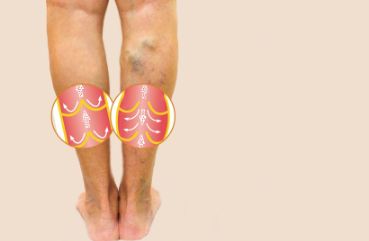
静脉血栓一般不会引起皮肤瘙痒,如果是皮肤瘙痒、皮疹等情况不排除皮肤病引起的。
因为下肢浅静脉血栓如果没有色素沉着、皮脂硬化、皮疹等情况,只是单纯的浅静脉血栓的话一般会出现局部红肿热痛。如果是深静脉血栓的话一般会出现下肢肿胀、疼痛。
但是如果是以前得过下肢深静脉血栓,现在出现血栓后遗症的话可能出现下肢静脉曲张、局部硬化、溃疡、皮疹、瘙痒等情况。所以,如果出现瘙痒具体什么原因引起的得通过病情、病史、查体、检查等综合判断,因为引起的原因不一样治疗也是不一样的。

小腿发紫不能就此诊断为静脉血栓。因为如果是浅静脉血栓的话一般不会出现小腿发紫的,会出现血栓部位的红肿热痛。如果是深静脉血栓得看病情程度,如果血栓不严重可能只是出现下肢肿胀、疼痛等症状,如果是肌间静脉血栓有些甚至没有症状,但是如果是下肢广泛血栓很重的话可能会出现下肢肿胀很明显并出现青紫,甚至会引起下肢动脉痉挛出现股青肿,股青肿需要及时治疗,如果继续进展下肢缺血逐渐加重的话可能会出现下肢的缺血坏死等严重的并发症。所以小腿青紫不一样就是静脉血栓,静脉血栓也不一定出现小腿青紫,具体什么原因引起的得根据症状、体征、检查等综合评估。

患者男,65歲,因陰莖根部一條索狀物伴疼痛1月就診。1月前自己發現陰莖根部皮下有一條索狀物,同時伴有局部疼痛,曾在西藏X醫院就診,予以輸抗炎藥物三天,肌注六天(具體診斷及用藥不詳),稍有好轉,遂到我院就診。
既往有糖尿病史,一直口服降糖藥,血糖維持在7.1mmoI/L;有腹腔鏡膽囊切除病史。
專科情況:陰莖背側體部至根部可捫及一條索狀物,質扁硬、觸痛;包皮長,覆蓋龜頭,可外翻;雙側睾丸、附睾未查見明顯異常;直腸直檢:前列腺居中、質偏硬、中央溝存在、觸痛,未捫及結節及包塊。
輔助檢查:血糖5.6mmoL/L,陰莖彩色多普勒檢查示:陰莖皮下O.7mm處探及一邊界不情的索狀低回聲區;全血分析、凝血四項、CEA、AFP、PSA示正常;EPS一RT示:PP<十 WBC22一27/HP PC O~7/HP。
診斷:l、陰莖背側條索狀物待查2、慢性前列腺炎3、包皮過長
與患者及家人溝通同意行包皮環切及包皮脫套至陰莖根部探查,術中見陰莖背深靜脈從陰莖體部開始一直延伸到陰莖根部深面擴張、發紫,觸之質硬,為陰莖背深靜脈血栓形成,完全堵塞血管,伴靜脈炎。由於原因不清、血栓形成及堵塞血管的長度不清,不能進一步手術。術中,術後反復與患者及家入溝通病情,無法切除“條索狀物"(擴張堵塞的陰莖背深靜脈),其條索狀物依然存在,並可能加重,只能採用藥物保守治療,必要時建議到上級醫院進一步診治。
術後診斷:l、陰莖背深靜脈血栓性靜脈炎(堵塞血管)2、慢性前列腺炎3、包皮過長
討論
陰莖的背側靜脈包括陰莖背淺靜脈和陰莖背深靜脈,陰莖背淺靜脈位於陰莖皮下、CoIles筋膜和BUCkS筋膜,在陰莖根部匯入陰部靜脈,再注入大陰靜脈。陰莖背深靜脈位於BUks筋膜深面及與白膜之間,常與陰莖背動脈伴行,陰莖背深靜脈與前列腺靜脈叢匯合後注入髂內靜脈。
更細的解剖分析:阴茎静脉回流分为三层,第一、表层静脉回流,有数条位于阴茎背侧浅筋膜儿和深筋膜之间的浅静脉组成,在阴茎根部会汇成一到两支,流入一侧或分别流入两侧的阴部外浅静脉,汇入大隐静脉,也通过阴茎根部的两到三支流入腹壁浅静脉。第二、中层静脉回流,阴茎头的多支小静脉在冠状沟后形成冠后静脉丛,汇集成一到两支,形成阴茎背深静脉的起始部,在接受阴茎海绵体血液,至阴茎根部形成阴茎深悬韧带,过耻骨弓状韧带,进入前列腺静脉丛,最终流入髂内静脉。中层静脉包括阴茎背深静脉和环静脉,接受阴茎头和阴茎海绵体的血液。第三、深层静脉回流,阴茎近端三分之一的导静脉,汇合形成阴茎海绵体静脉,在阴茎角内侧离开阴茎海绵体,形成阴部内静脉的起始部,沿途接收阴茎海绵体角静脉、环静脉、阴囊静脉以及直肠静脉,进入盆腔后汇入髂内静脉。上数三层静脉回流中,以中层的阴茎背深静脉为轴心,相互间有丰富的吻合支,血液回流,彼此沟通,静脉内有瓣膜、海绵体内的动静脉短路、窦状隙一些特殊的装置,在体神经和自主神经的调节下,动静脉间的循环非常的完善。引流海绵窦的小静脉起自阴茎海绵体表面的各个部位,此窦后小静脉(直径约30μm)相互吻合形成白膜下静脉丛(直径约50μm),并相互汇合后形成导静脉(直径约150μm)。
阴茎背浅静脉血栓性静脉炎又称阴茎Mondors病。其病因可能与频繁剧烈的性生活牵拉阴茎背浅静脉致其内膜损伤或长时间充血所致。亦有人认为与炎症、阴茎局部注射、肿瘤及手术等有关。阴茎背浅静脉血栓性静脉炎主要诊断依据为阴茎背侧近冠状沟处出现条索状肿物,略痛或无不适症状,表面皮肤略红(急性期)或正常,质稍硬,轻触痛或无触痛活动度好,并除外肿瘤,性传播疾病,必要时取病理确定诊断。阴茎背浅静脉血栓性静脉炎是一种良性病变,不同于肿瘤及性传播疾病。如果不是其他泌尿生殖病症继发改变并不影响勃起功能和生育能力。因此对此病要有正确认识,否则可能对此病进行错误治疗,给患者造成不必要的损失,尤其是基层医院更是如此。 此病的治疗,关键是明确诊断并向患者解释清楚,解除其思想负担及焦虑情绪,一般不必做特殊处理,症状可自行好转或消失,也可行局部理疗。如肿物明显或局部不适较重,可考虑手术治疗。
該病例為陰莖背深靜脈血栓性靜脈炎,實為罕見,臨床上雖有陰莖淺靜脈血栓性靜脈炎(Mondors病)的報道,有由於糖尿病繼發下肢靜脈血栓形成的報道,也有如腎癌形成的脈管癌栓的報道。但始終未檢索到陰莖背深靜脈血栓形成,乃至陰莖背深靜脈癌栓的報道。
由於陰莖背深靜脈是與前列腺靜脈叢匯合後注入骼內靜脈,也檢索前列腺癌有無癌栓進入陰莖背深靜脈,事實上結果令人失望,並且該患者前列腺影像學檢查和血清PSA檢查並無腫瘤的提示。
另一方面考慮是否存在外傷的因素,反復追問病史,已經排除。
那麽是什麽原因導致的陰莖背深靜脈如此嚴重的血栓性靜脈炎呢?最可能的因素是糖尿病對陰莖背深靜脈的影響。至於腫瘤引起的脈管栓塞到如此嚴重的程度更屬罕見。
目前僅能採取藥物治療如地奧司明、邁之靈、燈盞細辛等,至於是否可採取溶栓治療,有待進一步臨床探討和臨床運用的對照組病例分析。最明確的需要髂靜脈造影恐怕才能明白堵塞的具體範圍。

1、改善生活方式,避免久坐久站,戒烟、戒酒。
2、避免进食含糖高、易产气食物,忌食辛辣、油腻食物,病情许可,多进食汤、水。
3、保持大便通畅,防止便秘,避免排便时过度用力。
4、避免穿紧身裤,可穿束腿长筒袜或梯度弹力袜。
5、每晚睡前用热水泡脚和按摩20min。
6、卧床病人进行主动或被动床上肢体活动,并将腿抬高到心脏以上水平,促进下肢静脉血液回流,病情允许协助早期下床活动。
7、督促并帮助患者进行踝泵运动(一手固定于踝部,另一手握住前足做踝关节屈伸运动、足内外翻运动和足环转运动,双下肢交替,各做20次)
8、在距小腿关节下方4cm垫脚圈,使小腿腹部离开床面,避免膝下垫枕。
9、术中及术后早期使用弹力绷带或穿弹力袜以减轻肢体肿胀程度。
10、术后加强保暖,给予双下肢按摩。
11、及时发现有无一侧肢体疼痛肿胀,下肢周径和皮肤颜色、温度等变化,浅静脉有无怒张,有异常及时处理。
12、长期静脉输液或经静脉给药者,采用留置针或颈静脉穿刺置管输液。

以下内容来源于新英格兰医学杂志。
Presentation of Case

Differential Diagnosis
Movement Disorders
Seizures
Functional Movement Disorder
Dyskinesia
Limb-Shaking TIAs
Clinical Impression and Initial Management

Clinical Diagnosis
Dr. Albert Y. Hung’s Diagnosis
Pathological Discussion

Pathological Diagnosis
Additional Management
Final Diagnosis

以下内容来源于新英格兰医学杂志。
Presentation of Case
Dr. Christine M. Parsons (Medicine): A 75-year-old woman was evaluated at this hospital because of arthritis, abdominal pain, edema, malaise, and fever.
Three weeks before the current admission, the patient noticed waxing and waning “throbbing” pain in the right upper abdomen, which she rated at 9 (on a scale of 0 to 10, with 10 indicating the most severe pain) at its maximal intensity. The pain was associated with nausea and fever with a temperature of up to 39.0°C. Pain worsened after food consumption and was relieved with acetaminophen. During the 3 weeks before the current admission, edema developed in both legs; it had started at the ankles and gradually progressed upward to the hips. When the edema began to affect her ambulation, she presented to the emergency department of this hospital.
A review of systems that was obtained from the patient and her family was notable for intermittent fever, abdominal bloating, anorexia, and fatigue that had progressed during the previous 3 weeks. The patient reported new orthopnea and nonproductive cough. Approximately 4 weeks earlier, she had had diarrhea for several days. During the 6 weeks before the current admission, the patient had lost 9 kg unintentionally; she also had had pain in the wrists and hands, 3 days of burning and dryness of the eyes, and diffuse myalgias. She had not had night sweats, dry mouth, jaw claudication, vision changes, urinary symptoms, or oral, nasal, or genital ulcers.
The patient’s medical history was notable for multiple myeloma (for which treatment with thalidomide and melphalan had been initiated 2 years earlier and was stopped approximately 1 year before the current admission); hypothyroidism; chikungunya virus infection (diagnosed 7 years earlier); seropositive erosive rheumatoid arthritis affecting the hands, wrists, elbows, and shoulders (diagnosed 3 years earlier); vitiligo; and osteoarthritis of the right hip, for which she had undergone arthroplasty. Evidence of gastritis was reportedly seen on endoscopy that had been performed 6 months earlier. Medications included daily treatment with levothyroxine and acetaminophen and pipazethate hydrochloride as needed for cough. The patient consumed chamomile and horsetail herbal teas. She had no known allergies to medications, but she had been advised not to take nonsteroidal antiinflammatory drugs after her diagnosis of multiple myeloma.
Approximately 5 months before the current admission, the patient had emigrated from Central America. She lived with her daughter and grandchildren in an urban area of New England. She had previously worked in health care. She had no history of alcohol, tobacco, or other substance use. There was no family history of cancer or autoimmune, renal, gastrointestinal, pulmonary, or cardiac disease.
On examination, the temporal temperature was 37.1°C, the heart rate 106 beats per minute, the blood pressure 152/67 mm Hg, and the oxygen saturation 100% while the patient was breathing ambient air. She had a frail appearance and bitemporal cachexia. The weight was 41 kg and the body-mass index (the weight in kilograms divided by the square of the height in meters) 15.2. Her dentition was poor; most of the teeth were missing, caries were present in the remaining teeth, and the mucous membranes were dry. She had abdominal tenderness on the right side and mild abdominal distention, without organomegaly or guarding. Bilateral axillary lymphadenopathy was palpable. Infrequent inspiratory wheezing was noted.
The patient had swan-neck deformity, boutonnière deformity, ulnar deviation, and distal hyperextensibility of the thumbs (Fig. 1). Subcutaneous nodules were observed on the proximal interphalangeal joints of the second and third fingers of the right hand and on the proximal interphalangeal joint of the fourth finger of the left hand. Synovial thickening of the metacarpophalangeal joints of the second fingers was noted. There was mild swelling and tenderness of the wrists. She had pain with flexion of the shoulders and right hip, and there was subtle swelling of the shoulders and right knee. Pitting edema (3+) and vitiligo were noted on the legs. No sclerodactyly, digital pitting, telangiectasias, appreciable calcinosis, nodules, nail changes (including pitting), or tophi were present. The remainder of the examination was normal.

The blood levels of glucose, alanine aminotransferase, aspartate aminotransferase, bilirubin, globulin, lactate, lipase, magnesium, and phosphorus were normal, as were the prothrombin time and international normalized ratio; other laboratory test results are shown in Table 1. Urinalysis showed 3+ protein and 3+ blood, and microscopic examination of the sediment revealed 5 to 10 red cells per high-power field and granular casts. Urine and blood were obtained for culture. An electrocardiogram met (at a borderline level) the voltage criteria for left ventricular hypertrophy.

Dr. Rene Balza Romero: Computed tomography (CT) of the chest, abdomen, and pelvis, performed after the intravenous administration of contrast material, revealed scattered subcentimeter pulmonary nodules (including clusters in the right middle lobe and patchy and ground-glass opacities in the left upper lobe), trace pleural effusion in the left lung, coronary and valvular calcifications, and trace pericardial effusion, ascites, and anasarca. The scans also showed slight enlargement of the axillary lymph nodes (up to 11 mm in the short axis) bilaterally and a chronic-appearing compression fracture involving the T12 vertebral body.
Dr. Parsons: Morphine and lactated Ringer’s solution were administered intravenously. On the second day in the emergency department (also referred to as hospital day 2), the blood levels of haptoglobin, folate, and vitamin B12 were normal; other laboratory test results are shown in Table 1. A rapid antigen test for malaria was positive. Wright–Giemsa staining of thick and thin peripheral-blood smears was negative for parasites; the smears also showed Döhle bodies and basophilic stippling. Antigliadin antibodies and anti–tissue transglutaminase antibodies were not detected. Tests for hepatitis A IgG and hepatitis C antibodies were positive. Tests for hepatitis B core and surface antibodies were negative. A test for human immunodeficiency virus type 1 (HIV-1) and type 2 (HIV-2) was negative.
Findings on abdominal ultrasound imaging performed on the second day (Fig. 2A and 2B) were notable for a small volume of ascites and kidneys with echogenic parenchyma. Ultrasonography of the legs showed no deep venous thrombosis. An echocardiogram showed normal ventricular size and function, aortic sclerosis with mild aortic insufficiency, moderate tricuspid regurgitation, a right ventricular systolic pressure of 39 mm Hg, and a small circumferential pericardial effusion. Intravenous hydromorphone was administered, and the patient was admitted to the hospital.

On the third day (also referred to as hospital day 3), nucleic acid testing for cytomegalovirus, Epstein–Barr virus, and hepatitis C virus was negative, and a stool antigen test for Helicobacter pylori was negative. An interferon-γ release assay for Mycobacterium tuberculosis was also negative. Oral acetaminophen and ivermectin and intravenous hydromorphone and furosemide were administered.
Dr. Balza Romero: Radiographs of the hands (Fig. 2C through 2F) showed joint-space narrowing of both radiocarpal joints and proximal interphalangeal erosions involving both hands. Radiographs of the shoulders showed arthritis of the glenohumeral joint and alignment suggestive of a tear of the right rotator cuff. A radiograph of the pelvis showed diffuse joint-space narrowing of the left hip, without osteophytosis, and an intact right hip prosthesis.
Dr. Parsons: Diagnostic tests were performed, and management decisions were made.
Differential Diagnosis
Cancer
Infectious Disease
Autoimmune Disease
Hypocomplementemia
Dr. Beth L. Jonas’s Diagnosis
Pathological Discussion
Pathological Diagnosis
Discussion of Management
Follow-up
Final Diagnosis
Overlap syndrome of rheumatoid arthritis and systemic lupus erythematosus complicated by proliferative lupus nephritis, superimposed on amyloid A amyloidosis.

以下内容来源于PubMed。
Abstract
Sacituzumab govitecan (SG) significantly improved progression-free survival (PFS) and overall survival (OS) versus chemotherapy in hormone receptor-positive human epidermal growth factor receptor 2-negative (HR+HER2-) metastatic breast cancer (mBC) in the global TROPiCS-02 study. TROPiCS-02 enrolled few Asian patients. Here we report results of SG in Asian patients with HR+HER2- mBC from the EVER-132-002 study. Patients were randomized to SG (n = 166) or chemotherapy (n = 165). The primary endpoint was met: PFS was improved with SG versus chemotherapy (hazard ratio of 0.67, 95% confidence interval 0.52-0.87; P = 0.0028; median 4.3 versus 4.2 months). OS also improved with SG versus chemotherapy (hazard ratio of 0.64, 95% confidence interval 0.47-0.88; P = 0.0061; median 21.0 versus 15.3 months). The most common grade ≥3 treatment-emergent adverse events were neutropenia, leukopenia and anemia. SG demonstrated significant and clinically meaningful improvement in PFS and OS versus chemotherapy, with a manageable safety profile consistent with prior studies. SG represents a promising treatment option for Asian patients with HR+HER2- mBC (ClinicalTrials.gov identifier no. NCT04639986 ).
展开更多


























